We entered Honduras from Guatemala at the border crossing that takes you directly to the famous Mayan ruins at Copan. We had been told that this was an easy and straight forward border crossing and so it was. By electing to go into and out of El Salvador from Guatemala, we had avoided the more difficult crossings between ES and Honduras, two countries that are currently engaged in some disputes as to where the border actually is.
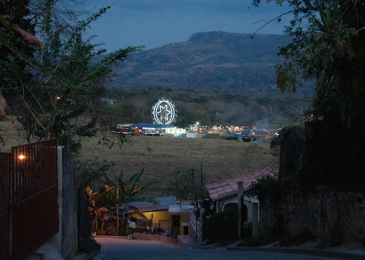
But this is a nice town, and famous ruins; we stayed two days. Upscale enough to be ready for tourists, with coffee houses, cobblestone streets, tours to nearby fincas, and pizza. At the Texaco station we ran into a couple of fellows from the states (Arkansas and Mississippi, by their accents); one has a house here and the other is a beekekeper who was visiting him and teaching the locals about honey production. It was great to hear American voices. We also shared our parking area with a German fellow traveling alone in an old US van.
And the ruins are quite nice. They contain the most intricately carved stelae in the Americas, and people go ape over them, even though we liked Quirigua better. Frankly, we were a little bored; and then we went to the museum they have erected on site. And this is one hell of a museum; built in 1998 and by far the best museum/visitor center of any of the ruin sites we have visited. You enter through the mouth of a serpent, and go down a tunnel which suddenly opens into an open-air two-story museum that contains some of the best of the sculptures from the site. The explanations were excellent, there is a replica in full color of an interior temple, and many detailed carvings. It is jaw-droppingly cool. The museum saved the entire experience for us.
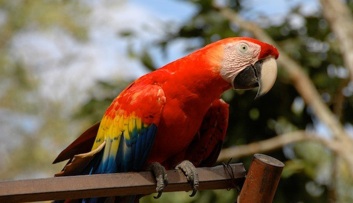
As we left town we made a brief stop at a local eco-tourist park that had a lagoon where herons are supposed to over-winter in great numbers. Way down a dusty road, across a stream, we found the lagoon; unfortunately, the herons either never had come or had already left. But we had a chance to exchange greetings with locals washing their trucks in the stream, and the lagoon was pretty anyway.
We worked our way north up the valley from the ruins, a lush valley with coffee growing on the hillsides, really traveling into Honduras for the first time (Copan is very close to the border, and, as mentioned, kind of touristy). We noticed we were seeing many more men on horseback, not merely carrying a burden but being ridden for pleasure. Some mighty fine horseflesh. We had heard that Hondurans are proud of their horses. And the other end of the same day we saw a fellow trudging along with his machete in one hand and talking on his cell phone with the other.
Well, no mas ruinas. We realized we had come to the end of our visitations to the archeological sites preserving the remains of these interesting ancient civilizations. Over the years we have visited locations from outside Mexico City all the way into Honduras. This is not a passion with us, but we are very glad each time we stop; we learn and appreciate, and feel fortunate to have these opportunities. Copan Ruinas marks the southern boundary of the Mayan civilization. Early dwellers further south have not left such distinctive monuments, although signs of them do exist. We’ll continue to keep our eyes peeled, and of course Incan sites await in South America.

In west-central Honduras we visited several small towns with nice churches. Gracias (you’re welcome) is a pretty little town ripe for stardom. It has reportedly the oldest church in the Americas, a nice central square, and is totally torn up because they are laying new streets. We suggest a visit in a couple of years, after they are all finished – right now it’s a mess.
Nearby is Celaque National Park, in a cloud forest. We took our usual trek up a tiny, windy, nasty road, heading for the visitor’s center and a quiet night’s sleep. Most of the way up we chickened out. Not being sure what we would find at the top, and it getting late, we opted to sleep beside the road. This left us on a steep slant, which was (just) okay for an overnight, but put the refrigerator into rebellion. You may not know this, but the type of refrigerators normally used in RVs require being level in order to work right. Ours said “noop,” and turned itself off. Well, all we lost was the milk (see above), and my frozen blueberries I’d picked in Alaska last summer were all a mess, but we were concerned about the total damage. So we contented ourselves with a hike up the rest of the way to the visitor’s center in the morning, and skipped taking a hike in the woods. And….we wouldn’t have been able to find a level place to camp anyway.
From Gracias we took a dirt road over to La Campa, through the pine forest. Another town with a nice square; this one pretty dry and dusty, but It was a nice ride. We wanted to see the town, but also afterwards we were headed for the town of San Juan, and then on to La Esperanza; our map said we could get there from here. Hah! Damn map; this road doesn’t go to San Juan, said the nice man on the side of the road. We were talking to him because we were stopped; we were stopped because the road was blocked by equipment trying to pull a huge truck out of a huge ditch where it had slid on its bald tires. That was going to take awhile, and we weren’t going to get where we wanted to be anyway. So back to Gracias and take the “main” road to La Esperanza.

We were the entertainment most of the time (although at one point a rooster across the street decided to take on a turkey he didn’t like the look of, and it was very exciting for awhile; the turkey finally prevailed). We had decided to watch a movie, and happened to choose The Motorcycle Diaries. It was great, because the kids gathered around and watched with us, at least until the motorcycle gave out and there was less adventure involved. Then the kids disappeared and the older folks stopped by to take a look. At one point we were approached by a fellow bringing another man with him; the man was sick, and they were hoping we had some medicine we could give to them. We passed along some aspirin, but were reluctant to go further than that. Afterwards we remembered that there has been a lot of public service medical work done in these rural areas, and they probably thought we were visiting doctors. We hope the aspirin helped.
Okay, up we got in the morning and tackled this road ahead. We knew all about it from others who had passed this way. Well, it lived up to its reputation; this was the worst not-under- construction road we’d seen yet in our travels. But we finally reached La Esperanza, and it really was well worth all the trouble. You see, it was Sunday, and La Esperanza has a really good produce market that day each week. And being Sunday, all the people in the area are in town, so it’s a good day for people-watching. And there’s a nice (lovely, in fact) church, and…..it was Palm Sunday and morning services were just letting out. How many reasons do you need? We had a wonderful time. Great radishes and carrots, great people-pictures, and oh, yes, an ATM (thank you, thank you!).
Comayuaga, Honduras’ historic early capital, was next. We were now back on pavement, and quickly moved through Siguatepeque toward our goal. It was that hot; when we hit town we noticed it was 99 degrees – in the shade. Sunday afternoon was quiet in the old town square, a lovely spot. We wandered around anyway, seeing several ancient and lovely churches and other assorted old buildings. We had hoped to overnight here, but our information required starting at the tourist office, and they had closed at noon (on a Sunday!) and were even closed on Monday as well, so we ultimately beat feet back to Siguatepeque, at a higher elevation, and with a known secure spot at a Shell station along the highway. it was noisy, but we managed. (We are finding fewer and fewer official-type places to camp and having to make do with what’s possible. At least we had a security guard, water, and a place to dump tanks – oh, and a Domino’s across the street.)
Everybody on the road was headed up to the coast for Semana Santa. We hadn’t been able to come up with someplace to be for the week, and so we decided to grin and bear it. Our plan was to follow the route we’d decided on, stay somewhere if it was possible, and if not then just move on. This is a bit risky, of course, but we did make it work. We left Siguatepeque on Monday morning, knowing in a week it would all be over with. There are two main areas where Hondurans head on holidays, the Lago de Yojoa area, and the northern coast/Bay islands. We were headed for Lago de Yojoa. (By the way, you just try typing that word – it’s hard!)
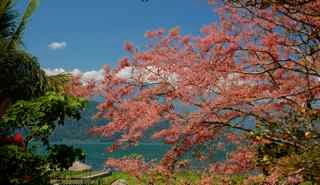
The Brewery is owned by an American (they are all over Central America), and we met several English-speaking folks during the very fine meal (and beer) we enjoyed. It was great to compare notes on traveling, and hear from a local birder all about what we could do in the area. It all sounded great, but as you know by now, getting up at 5:30 isn’t for us. We aren’t even dilettantes when it comes to birding. (Leslie and Elliott, you really must come here!!!)
But this area is so lovely. We started to move further north, the road ever more lush and gorgeous. With the bright red dirt and sugar cane, we were strongly reminded of Kauai, where we had spent many happy times. We stopped at the famous Pulhapanzak Falls on Rio Lindo, really cool. This is 43 meters high (you figure it out) and drops into a large swimming hole. Actually, the site is operated as a private balneario with restaurant, water slide, and several play areas. People camp here, and we had been considering it, but not during Semana Santa, no way! There were people everywhere, enjoying picnics by the water, playing music, and generally having a marvelous time. Let’s party!
We took our lives in our hands, and headed for the north coastal area, home of the Bay Islands (think Roatan) and Tela-La Ceiba –Trujillo, all popular beach towns along the Caribbean coast. What were we thinking! Well, we really did want to see some of the coast, regardless of (1) the crowds, (2) we aren’t beach people, and (3) it was already hotter than hell and we were still up 2000 feet in elevation. The road to the coast is the main road through the country, and it was very busy. We had been warned that it was a dangerous road at this time of the year, because of all the drinking and crazy drivers, but what the hey. We took it cautiously, there were plenty of police trying to keep things under control, and we did all right.
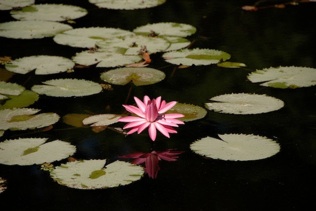
We spent a short time in Tela, right on the water, dipping our toes in the Caribbean. It is a lovely beach, and we had found a spot at a nice public park that wasn’t crowded - yet. But hot – whew! And lots of evidence of the big holiday festivities ahead. Off we went, on along further east and La Ceiba. We stopped there because we knew there was a real grocery supermarket. We are having real difficulty finding things – decent cheese, stuff like that. So we stocked up, noticing that we could get stuff we hadn’t seen in weeks; but the prices were terrible. It was a beautiful sunny day, green and lush, and as we navigated the northern coast, we saw lots of small streams and larger rivers coming to the coast from the mountains, each one lovely and clear and rocky. There were Cruce des Ganados (livestock crossing) signs everywhere, with all kinds of critters all over the roads mixing with the trucks filled with bananas and workers on their bicycles. This is a nice area, if it would ever cool off! The refrigerator is panting again; I’ve lost milk, orange juice and bread to the heat and humidity. Whine…..
We bought a watermelon (our favorite fruit these days) from an old man riding a cart filled with them that was pulled by an old horse; I got to pet the horse for free; the watermelon cost me about a buck and a half. We ate off it for four days.
We turned south when we left La Ceiba, heading into the mountains. We had toyed with the idea of continuing along further east and visiting Trujillo. Trujillo is where ole Chris Colombo landed, and has several interesting things going on. But we’d just had enough of all the crowds and the heat. We decided to spend the night in Saba and then head for a national park above La Union that we’d heard about. Once we made the turn south toward Saba we lost all the traffic; yes!
Saba was interesting. By now it was Wednesday evening of Easter Week. Saba is a company town (Dole) that is a stop-over spot on the way to the coast. We had heard about a hotel that would probably let us park in their lot. They were, indeed, happy to have us; there was a pool which we enjoyed, and we were certainly the entertainment for the other guests. We’re getting used to this. The hotel was interesting because it was kind of like an Executive Suites (but without the suites); it was a business traveler’s spot. We had a quiet night, our fans kept us within reach of cool enough, and the next morning we were ready to move on but needed to find an ATM. (By now you may have figured we are using cash for everything and relying on ATMs for funds. This works very well except in rural areas where you may not even be able to find a bank.) well, hmmmmm, all the banks are closed. Big signs, closed from Thursday to Sunday for – guess what – Semana Santa. These countries really take this holiday seriously. And, there are no ATMs in town anyway.
We knew we were heading down a dirt road, into the mountains, and there were no sources of money in our near future. So we took a short detour. We went partway up the road to Trujillo, having been told there was an ATM in Tocoa, 20 kms away. And there was – the bank was closed, but the ATM was working. I felt very sorry for the young couple standing in front of the bank trying to figure out what to do; I’m sure they had no ATM card and had counted on being able to get money out of their account. (And by the way, you should have seen the lines at the banks on Monday morning, after the holiday was over.)
Anyway, back in Saba we headed south, taking a dirt road that headed into the mountains toward La Union, leaving the lovely pavement behind. And it was a bitch of a road (my language is getting worse as the roads do the same; sorry). We had a beautiful ride; the country is really great, with neat views at every turn. It got drier as we climbed and we lost that lush quality to the countryside we’d been enjoying. Hours and hours and hours later, we found ourselves in La Union, a nice little mountain town that was thoroughly enjoying the holidays. Looked like a town party was about to start as we traveled through, heading toward La Muralla National Park, up in another of Honduras’ great cloud forests.
The road up the mountain was another of our gems; in parts it was really good, but where the heavy rains had done their job well it was a real mess. But we got all the way up to the visitor’s center, and found a nice spot for the night. The place was deserted, no caretaker, but a couple from the city was staying the night, and they had gotten the key and did let us into the building to look around. We had the pleasure of signing the guest book, and found the names of friends who had been here in 2003 and who had led us to come here ourselves. There were many trails into the forest, and we knew our friends had seen quetzals here, but in the intervening years the trails have badly disintegrated, and there was no reliable signage. As far as we walked, it was beautiful; we had rain off and on while we were there, so it was all misty and damp. I do love cloud forests! The couple departed in the morning and we had the entire area to ourselves most of the day. Two or three small groups came through, leading to interesting experiences.
The first group was a family who owned a coffee finca 4 kms down the road; they were checking on their plantings. At this point we ran up against some of our fears. This is hard to put to paper. We know we are on the edge of our comfort level at times here in Central America. Americans generally (and us particularly) are used to: (1) establishing and maintaining their privacy and the physical space around them; (2) voices at a “normal” level; (3) not being stared at; and perhaps most important: (4) being able to establish common ground with folks, talking enough to determine who people are and what they are “all about.” This group immediately challenged all four of those issues.
The group was comprised of about 13 people ranging in age from maybe 8-9 to a couple in their mid-40s. They shouted back and forth across the clearing, 2 of the teenagers were carrying guns (serious firepower here, the ubiquitous combination of an M-16 and a shotgun) and roamed around our coach examining it from head to toe. They were a happy crowd, laughing and enjoying themselves. Several of them took off up a trail and were gone for quite awhile (we found out later they had been checking the property), while the rest poked around the buildings and took their ease, always with part of the group eyeballing us. We were increasingly uncomfortable, and deciding that they looked like they were going to stay all day, and perhaps we should take off (we had earlier decided to remain for a second night in this lovely spot). We had said hello when they first arrived, but not much else passed back and forth between us.
However, it all changed when those who went up the trail returned. The family’s mother, very outgoing, came to the coach, shouted “Hola, mi amiga” and started in chatting with me. She was very friendly, quite determined to break down the barriers, and we quickly made friends. This is when we found they had their plantation (150 acres – quite large) home down the hill a ways; and indicating the guns, we asked about security for us in the area. No problema they assured us, turns out they kept an eye on things all around their property. The end result was we felt great again about staying where we were, and accepted their invitation to visit with them the next day when we came back down the mountain. It was really great!
One other thing about guns down here: we see them every day. Every bank, pharmacy or larger store has uniformed armed guards with either an M-16 or shotgun; sometimes the shop owner himself will be carrying a sidearm in a holster, often with extra clips of ammunition on his belt. We don’t really know what to make of this armed presence, as the general population we come into contact with seems happy and easy going, not threatening at all. I asked Steve, the manager of Bruno’s back in Rio Dulce, about it and he said it was largely a carryover from times past when such security was a legitimate concern. He said that at least for some folks, if a business doesn’t have security on site people will be reluctant to work there thinking they may become a target because they are unprotected. Whatever, occasionally we experience some discomfort, but have pretty much accepted the situation. By the way, for comparison purposes, it is not all that different than what you see in Mexico, but it is more prevalent down here.
One other group that came by was half-a-dozen teenage boys, who simply arrived, sat shyly on a ledge and watched us quietly for about 15 minutes, gestured they would like a little money, and left when we refused. A bit more unsettling, but we were still bubbly from our new coffee friends, and didn’t let it bother us. Towards the end of the afternoon a small family hiked by, said hello, admired the coach, “Buen Carro”, and moved on. It rained off and on all day, but cleared before dark; we were alone, the birds were singing, it was delightfully cool, and we enjoyed a quiet evening inside and settled down for the night.
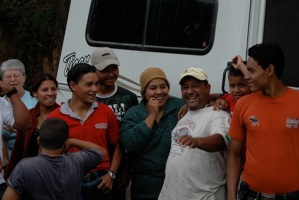
We cannot overstate the pleasure we took from getting to know these people. They were friendly and interested in us, happy to talk about themselves and their life, showed us all the apparatus and processes of a working finca, and poured us a cup of great coffee to boot. Before we left we invited everyone to come see our “casa rodante” and took lots of pictures, which we will send to them. We also were able to take a bag of coffee with us, keeping intact our plan to buy coffee in each country we visited. They wanted to give us the coffee, but we really wanted to be able to thank them financially for all they had done for us. Hugs and kisses around, we continued on down the road. By the way, they spoke almost no English, all of this was accomplished within the limitations of our extremely limited Spanish abilities. We find more and more that when we encounter someone who will speak slowly and limit their vocabulary and just work with us, we can communicate pretty well with them and it is very enjoyable all around. It seems pretty clear that the folks who make this effort with us always have some background in working with Gringos somewhere.
We had been a little concerned about being able to get off the mountain; the road is quite steep and in bad shape in places. We had experienced quite a bit of rain while we were there, and our friends had commented this would not be a good road in rainy weather, partly because there is a river to ford down near the bottom. But no problema. At the ford, folks were washing cars and enjoying playing in the water; we waved, crossed, and went on.
Ahead of us lay about 3 more hours of dirt road, but lovely vistas and a pleasant drive. We finally reached pavement (yes!) in Limones, and then made quick work of it to our next “road experience.” We were heading toward Valle de Angeles, a mountain town above Tegucigalpa (the capital). We wanted to come in the back way, and enjoy La Tigra National Park, a cloud forest that lay along this secondary route – also hopefully avoiding the crowds we anticipated at the main entrance area as this was Easter Weekend, the grand culmination of Semana Santa. And we met our worst road yet. All went well as we headed into the mountains, we even had a section of pavement; then we visited San Juancito, a charming old mining town (burros wandering down the middle of these tiny cobblestone streets), and then headed up the hill to El Rosario, the back entrance into La Tigra. This was a very bad decision – well, almost. We had read that you can camp the night at the visitor’s center at this park entrance. Yeah, well, sure. But you have to get there first. This was very steep, very tight and windy, very rocky, very narrow with tight uphill hairpin turns that we only just were able to make, and had lots of traffic on this, Friday afternoon of Semana Santa. Well, we finally got there. And the small parking area was so steep there was no way we could even get sort of level. Once again we were thankful to have chosen the Tiger (newly renamed La Tortuga – The Tortoise). Anything bigger or with less ground clearance would not have made it up this hill.
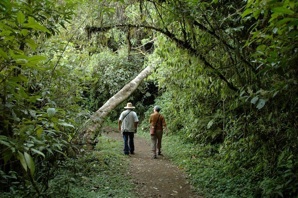
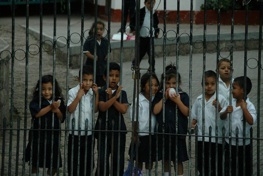
Tegucigalpa is still in the mountains, and in a very nice setting. We hadn’t planned to stop, and easily made our way around the city; quickly finding ourselves on the road to the Nicaragua border, a couple of hours away. We weren’t planning to cross the border today, but found nothing to hold us back. Suddenly, the border approached, Rick grabbed his paperwork, and about 45 minutes later we were in Nicaragua. How about that! Damn, he’s getting good at this (but we know worse borders are ahead). Nicaragua deals in cordobas, incidentally; about 15 of them to the dollar. New money to convert each time you buy a watermelon. Cool.
We loved Honduras. We spent 12 days there in all, and enjoyed everything about it (except perhaps the roads that needed help). The people were unfailingly helpful along the way, and friendly when given the chance. On the roads, we continue to find that paved roads down here tend to be pretty darn good, better than many of the roads in Mexico. But there are fewer of them so the wandering traveler who wants to experience rural areas spends a higher proportion of time on unpaved roads, which tend to be quite bad. Unlike northern Canada, the dirt roads down here do not seem to receive any regular maintenance. They just are what they are, which is uneven, rocky, and rutted. As to the people, well they are just wonderful. We find ourselves experiencing more and more delightful encounters with these friendly, happy folks. They take life as it comes, working hard and enjoying a life without all of the pressures and distractions we are all so used to, and just seem so pleased to have a chance to meet us. It is proving a wonderful experience.
We are in Nicaragua now, at the Club Campestre outside the town of Esteli, continuing our trek towards the Panama Canal. We wish we had started sooner in the winter; we have a sense of time passing too quickly. We know that Costa Rica and Panama have definite rainy seasons that will begin about the time we get there (rats) and that it’s not going to get any cooler. But hey, it’s all too much fun to stop!
Best Wishes and Happy Travels, Rick, Kathy and Trav’ler (aka La Tortuga)
Click here to see more of our pictures of Honduras






